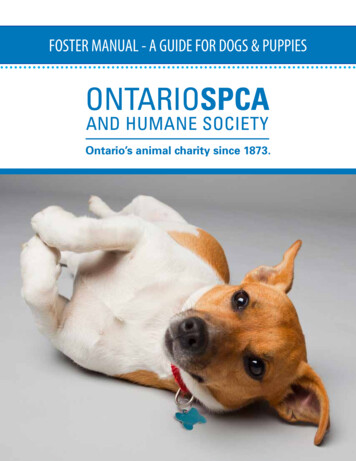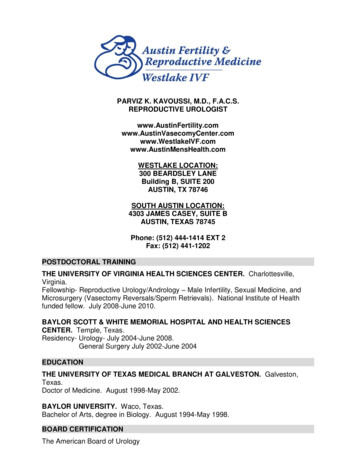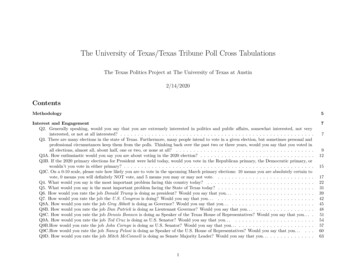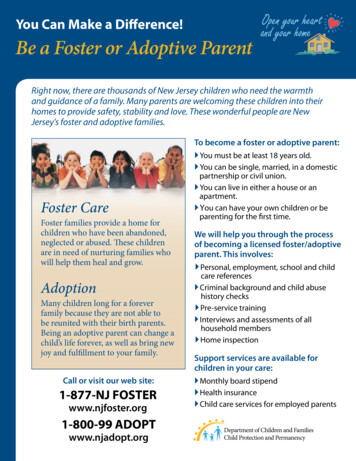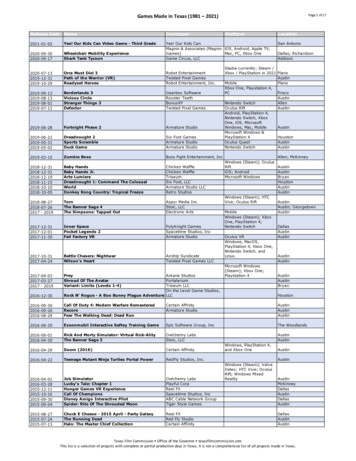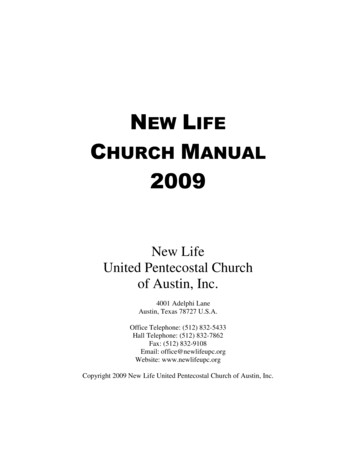
Transcription
Foster Program ManualAustin Animal Center7201 Levander Loop, Building AAustin, Texas 78702Revised 4/9/2019
Table of Contents1Table of Contents2Is Fostering for the Austin Animal Center Right for You?3Testimonials from Current Foster Care Providers4-5 6-10 11-12 14 Foster Program Policies and ProceduresLegal GuardianshipRecords and RetentionHousing and Care Requirementso Puppies and Dogso Kittens and CatsAdditional RequirementsSuppliesHealth and TemperamentFoster Pet AdoptionsHow it WorksGetting StartedSelecting a Foster PetPicking Up a New Foster PetMy foster pet is lost! What should I do?Medical Careo Basic Wellness (Vaccinations and ParasitePreventatives)o Sick or Injured Foster Petso Fading Kitten Syndromeo Fosters Puppies or Kittens with Fleas, Ticks, or otherParasiteso Prescription Dietso In Case of an After Hours Emergencyo Scheduling Spay/Neuter Surgery and Microchippingo Complications After Having Surgery at Emancipeto Medical Recordso Deceased PetsHow can I help my foster pet find a forever home?My foster pet has a potential adopter, now what?Adoption EventsReturning Foster Pets to the ShelterShort Term FosteringRequirementsStepsTiming for taking a dog outKennel Signs and SuppliesKeep the following in mindShare the experience Required Reading and/or Viewing for Puppy/Dog FostersDecompression Tips for New Foster DogsDog Body Language: Understand What Dogs Are SayingCommon Dog Behavior Issues: Leash ReactivityCommon Dog Behavior Issues: Separation AnxietyCommon Dog Behavior Issues: AggressionDog Bite PreventionKids and Dogs: How Kids Should and Should Not Interact withDogThe Safety Guide to Children and DogsHouse TrainingCrate TrainingTraining: Nothing in Life is FreeEnrichment and ExerciseHow to Introduce Dogs to Each OtherHow to Introduce a Dog to a Cat14-15 Additional Resources for Puppy/Dog FostersNursing Dog and Puppy CareBasic Puppy Care and SocializationHeartworm DiseaseRingwormDemodectic (Demodex) MangeSarcoptic Mange15 Required Reading and/or Viewing for Kitten/Cat FostersThe Do’s and Don’ts of Introducing CatsHow to Introduce a Dog to a CatCommon Cat Behavior Issues: AggressionCommon Cat Behavior Issues: Litterbox ProblemsFoster Kitten FAQFading Kitten Protocol Additional Resources for Kitten/Cat FostersNursing Cat and Kitten CareBottle Baby Kitten CareHow to Make Gruel for Kittens/CatsHow to Syringe Feed Gruel to Kittens/CatsFeline Upper Respiratory Infection (URI)Ringworm1516Want to connect with other fosters, volunteers and staff?17Contact Information18-19Foster Agreement13 Public Outings and Walks - Safety Tips for You and Your FosterDog1
Is Fostering for the Austin Animal Center Right for You?FAQHere are some frequently asked questions that may help you decide.What is fostering?Fostering is providing a temporary home for a homeless pet, who for whatever reason, needs to be housed outside of theshelter. Fostering is truly lifesaving.Why should I foster?Fostering can be a wonderful experience for you and your family. You can feel good knowing that you have made apositive difference in a pet’s life, and each pet fostered in a home opens up a cage or kennel space for us to save anotherpet! Fostering can also provide the individual attention that some pets require. Foster commitments range from just acouple of days to several months, so you can choose a foster option that fits your lifestyle.Do I need to have any special training or skills to be foster parent?Foster care providers should be compassionate and patient. You will be informed of their foster pet’s known history andany special needs before placement in your care. The foster coordinator will also be available to help answer questionsand provide resources as needed.What are the requirements? Be willing to abide by policies and procedures in the manual and foster care agreement Be able to access email regularly Be able to provide transport to and from AAC Provide some supplies and food for foster pets Spend time with foster pets and love them like your own Have up-to-date rabies vaccinations for all pets in the homeWhat types of pets need foster care? Kittens and puppies too young to be in the shelter Pets recovering from illness or injury Pets that need a break from the shelter environment Pets with special medical or behavioral challengesHow long do pets need to be in foster care?Every situation is different! Foster needs range from a couple of day to several months or until the pet is adopted.How much time do foster parents have to devote to the pet(s) in their care?It depends on the situation. Foster pets need all of the same things that owned pets do, and may require even moreattention if they are recovering from an illness/injury or need behavior modification.What are some of the potential risks of fostering a pet?Fostering is one of the most rewarding experiences that you can have, but there are some potential risks. While rare, risksinclude but are not limited to Other pets in the home could catch a disease and/or a parasite from a foster pet Foster care providers, members of their household, or visitors could catch a disease and/or parasite from a fosterpet Other pets in the home could be injured or killed by a foster pet. Foster care providers, members of the household, or visitors could be injured by a foster pet Foster pets could die in foster care or have to return to the shelter to be euthanized Foster pets may destroy personal itemsWhat happens if my foster pet needs medical care?Medical care is provided by the veterinary staff at AAC.Can foster care providers adopt their foster pets?Yes. Foster care providers may adopt their foster pet(s), but should notify the foster coordinator of their decision as soonas possible so that appropriate arrangements can be made.2
Testimonials from Current Foster Care ProvidersWithout fosters, Austin could not be No-Kill. Pets who are too young, sick, hurt, or simply not behaviorally suited for theshelter need a helping hand to bridge them to their forever home.We recently had three senior cats surrendered whose owner had a stroke. If I were in that situation I would want to knowthat someone would take my babies under their wings until a new home could be found for them. When you foster an pet,you're also frequently helping a person out as well. And as an extra big bonus, fostering lets me get my kitten fix over andover again! – Beth B.It always warms my heart to hear from people, too. Adopters have randomly stopped me with hugs months later at thegrocery store. I've opened the mail to find a crayon-drawn thank you card. Some of my favorite moments are reading theupdates that adopters share with me. They send photos of their new family member settling in to the good life, nappingwith new friends, wearing their first Halloween costume, and even joining the family portrait. I can’t help but smile. I feeltremendous satisfaction knowing that I’ve fostered a pet in need. I’ve fostered happiness in someone’s life. I’ve fosteredjoy in my own soul. – Kelley R.I usually have medical fosters, which are dogs or cats that are recovering from surgery or illness.I Foster because it gives me great pleasure, I love to see a pet get through all of life’s hurdles and get adopted by awonderful new family. My kids love fostering because they always have a “new” pet to cuddle or play with. I feel it alsohelps my kids to understand that as people we should care for all living things, and take care of them to the best of ourabilities, and I feel that translates to our relationships with other people as well. Besides, who knows one of my childrenmay be a future veterinarian, or a vet tech, just like their mom. – Nancy L.It feels good knowing that in our own small way, we have made a difference in their lives and have helped Austin remain ano kill city, which I love! I also foster because it is a wonderful experience for my children. It teaches them about giving ofthemselves and teaches them responsibility in helping take care of the many puppies we have had in our home over theyears. It also allows them to always have puppies around to play with! I also love that we have met some really greatfamilies over the years and remain friends with several of them. It is an amazing thing to see a dog who came into myhome emaciated, covered in fleas, scared to death and taking care of a litter of puppies to six months later seeing her ather new home completely pampered and loved and cherished by the wonderful couple that adopted her. – Kimberly L.3
Foster Program Policies and ProceduresLegal GuardianshipAll pets in foster care are the property of the Austin Animal Center and are subject to all applicable Austin Animal Centerpolicies, rules and restrictions.Foster care providers must return foster pets at any time upon the request of the foster coordinator or other Austin AnimalCenter staff. Austin Animal Center staff may request the return of a foster pet for many reasons, including but not limitedto: the opportunity to be reclaimed by a previous owner or the opportunity to be transferred to a partner organization.If a foster care provider is found to have improperly transferred a pet to another individual or entity, the foster careprovider will be permanently removed from the foster program and the Austin Animal Center may initiate appropriate legalaction in order to secure the return of the pet.The Austin Animal Center reserves the right to perform home checks in order to ensure that foster pets are beingadequately and appropriately cared for.Records and RetentionFoster care providers are not authorized to alter records provided by the Austin Animal Center. This includes both digitaland hard copies of a pet’s medical and/or behavioral history.Foster care providers are expected to retain communications regarding their Austin Animal Center foster pets, includingthose between themselves and potential adopters.Housing and Care Requirements Foster care providers are expected to follow and abide by all guidelines and protocols regarding proper care offoster pets, including giving them proper food, access to water at all times, daylight, socialization, health care, etc.Foster pets must be kept in climate controlled homes where the temperature is kept between 60 and 80 F. Foster care providers are only allowed to treat foster pets with medications and supplements prescribed by AustinAnimal Center’s veterinary staff, unless alternative care arrangements have been approved by the fostercoordinator.Puppies and Dogs Puppies should never be left unsupervised outdoors, and high traffic areas, such as the park, pet stores,public sidewalks/trails, etc., should be avoided, as puppies can be susceptible to deadly diseases thatcould be lurking there. Dogs can go outside for supervised play time/exercise. While outdoors, foster dogs must be kept on leashor in a securely fenced yard. Some dogs can jump/climb over or dig under fences surprisingly fast, soplease be cautious when leaving foster dogs unsupervised. Foster dogs that do not have a prior history with each other should not be combined in a foster homeunless the foster care provider has sought and been given permission by the foster coordinator. Foster dogs are prohibited from socializing with other dogs, except those living in the foster careprovider’s home. Foster dogs are prohibited from going to off leash dog parks or other off leash areas. Dogs must be onleash, under your control, at all times. During walks, a minimum 10-feet should be maintained between fosters dogs and other pets, exceptthose also living in the foster care provider’s home.4
Kittens and Cats Kittens and cats in foster care should be kept indoors only. When being transported, cats and kittensmust be kept in secure carriers.Additional Requirements Children under the age of 18 should not be left unsupervised with any foster pets. Foster care providers must notify the foster coordinator immediately if a foster pet bites a person or pet and thebite breaks the skin. If injury or illness results from interaction between pets in your home and foster pets, Austin Animal Center willonly be responsible for the medical care and expenses of the foster pet. In some cases, you may be asked tokeep your pet separate from the foster pet for a pre-determined period of time to prevent the spread of illness toyour pet. If a foster pet is lost, the foster care provider should contact the foster coordinator immediately. For more details,see the “My foster pet is lost! What should I do?” section.SuppliesAAC will provide foster care providers with certain supplies Food for puppies and kittens (this includes formula when needed)Any medications, supplements or prescription diets that have been prescribed by our veterinary staffOther items (based on availability and need)Health and TemperamentAAC will be as accurate as possible when providing information about the medical and behavioral health of pets seekingfoster placement, but cannot guarantee the medical or behavioral health of any pet.Foster care providers are required to be as accurate as possible about their foster pet’s health and behavior. This willassist the shelter in determining the proper medical treatment, training and/or behavioral rehabilitation for the pet.Foster Pet Adoptions All foster pets must be fixed (spayed/neutered) and microchipped before they can go to their forever homes. Potential adopters must be go through an approval process. For additional details and instructions, see the “Myfoster pet has a potential adopter, now what?” section on page 9. Foster care providers may adopt their foster pet(s), but should notify the foster coordinator of their decision assoon as possible so that appropriate arrangements can be made.5
How it WorksGetting StartedAfter your foster application has been received and approved, you will receive a welcome email and we will invite you tojoin our web-based group, which is how we communicate with our foster care providers.Prior to fostering any pets, you will be required to sign the foster agreement (see pages 18-19), which will be kept on fileat the shelter. In addition, within three months of getting started, you will be required to attend a foster programorientation.If at any time you have questions regarding the foster program, pets that we are pursuing foster placement for, etc.,please contact the foster coordinator.Selecting a Foster PetAfter you have joined the foster program’s web-based group, you will begin receiving placement pleas for pets in need. Ifyou are interested in fostering any of these pets, please contact the foster coordinator as soon as possible. Once wereceive your interest, we will verify that the pet is still available, answer any questions that you may have, and confirm apick up date and time. If you are looking for adult or senior dogs to foster, you can find many of them on our AAC AdultDog Foster Needs Trello board. You are also invited to visit the shelter and browse long stay dogs (those that havebeen at the shelter for 30 days). These dogs can be identified by the “intake date” on their kennel cards and many ofthem are available for placement in a foster home.Picking Up a New Foster PetWhen picking up a new foster pet, please go to the Main Lobby and into the Cashier’s Office. Let the Customer Servicestaff member know that you are a foster and that you are picking up a foster pet. You will need to have the pet’s IDnumber (found in the placement plea or on the pet’s kennel card) with you. You should request a printed copy of theirpaperwork to take home with you. After picking up your foster pet you will receive a “Foster Pet Schedule” email withadditional details regarding their care and their future medical needs. Please be on the lookout for this email! It will be sentwithin one week of pick up.The Main Lobby and Cashier’s Office are open daily from 11 a.m. to 7 p.m. If you are not able to come duringthese hours and would like to make arrangements to pick-up earlier in the day, please contact the fostercoordinator.My foster pet is lost! What should I do?1. Notify the foster coordinator immediately at animal.foster@austintexas.gov and 512-978-0541.2. Start searching!3. Visit and join the Austin Lost and Found Pets Facebook Page to post photos and information about the missingfoster pet.4. Post and search for the lost foster pet on Nextdoor.com and Craigslist.org (in the Community section under Lost& Found and Pets).5. Create and distribute flyers and post signs in high traffic areas (vet clinics, pet stores, groomers, pet boardingfacilities and other local businesses). Please ensure that your flyers and signs do not violate City of Austin signregulations, click HERE for information. For display and design tips, click HERE. If you need assistance with this,please notify the foster coordinator.6. Call 311 to make a “Lost Property” report. Afterwards, forward the report # to foster coordinator.Please note: Additional guidelines, instructions and support will be provided by the foster coordinator on a situational,case-by-case basis.Medical CareBasic Wellness Services (Vaccinations and Parasite Preventatives)All foster pets under four months of age should have their weight checked and be given booster shots every 2-4weeks. This means that kittens and puppies that are very young when they go to foster care may receive as many6
as four boosters. Foster pets over four months of age when they go into foster care may need to return to theshelter for a booster shot 2-4 weeks after their initial shot.All foster pets over eight weeks of age should be given flea/tick and heartworm preventatives monthly. Sincethese medications are based on the weight of the pet, if your foster pet is still growing, they will need to visit theshelter to receive the appropriate medications. If you are fostering an adult pet whose weight has not changed,they do not need to visit the shelter, you may simply contact the foster coordinator to arrange to pick up theappropriate medications.Please note: Due to the large number of pets in the foster program, it is up to the foster care provider to keeptrack of their foster pet’s booster shot and preventative schedule.To schedule an appointment for basic wellness services, please click HERE. Each week’s schedule willbe posted on or before Wednesday of the preceding week.The Austin Animal Center is currently utilizing a livestock trailer as a basic wellness clinic for foster pets.When you arrive for your appointment, please pull around to the back side of the shelter and park in thePet Resource Center parking area near the livestock trailer. You will then check in with staff in the trailer.Foster care providers should plan to arrive 5-10 minutes before their scheduled appointment.If you are unable make an appointment and would like to discuss alternatives, please contact the fostercoordinator. Please do not bring your foster pet to the shelter for medical care without an appointmentand expect them to be seen while you wait.Sick or Injured Foster PetsIf you notice that your foster pet has previously undocumented hair loss, cold-like symptoms (sneezing and/orcoughing occasionally, clear ocular or nasal discharge), occasional diarrhea and/or vomiting, but is otherwisealert, active, eating and drinking well, please notify the foster coordinator so that it can be determined how best toproceed.If your foster pet has more severe symptoms, such as yellow/green ocular or nasal discharge, extreme lethargy,frequent diarrhea and/or vomiting, etc., you will need to schedule an appointment for them to be examined ourveterinary staff.Please note: If you are fostering a litter of kittens or puppies, even if only one pet is showing symptoms, the entirelitter should be brought in.To schedule an appointment for your foster pet(s) to be examined by our veterinary staff, please clickHERE. Each week’s schedule will be posted on or before Wednesday of the preceding week.When you arrive for your appointment, please pull around to the back side of the shelter and park in thePet Resource Center parking area. You will then check in with staff in the Pet Resource Center to let themknow that you are here.- Foster puppies and dogs should be left briefly in your vehicle while you are checking in.- Kittens and cats that are secured in a carrier can be taken to the Pet Resource Center with youwhile you check in.We will do our best to see foster pets at the time of their appointment, but please plan for a 15-30 minutedelay, just in case!If you are unable make an appointment and would like to discuss alternatives, please contact the fostercoordinator. Please do not bring your foster pet to the shelter for medical care without an appointmentand expect them to be seen while you wait.Fading Kitten SyndromeFading Kitten Syndrome is a life threatening emergency in which a kitten, sometimes one that was previouslyhealthy, “crashes” and begins to fade away. Symptoms include:Low body temperature – the kitten feels cool or cold to the touchExtreme lethargy - not getting up, unable to stand, not responding to touching/pettingGasping for breathMeowing/crying outPlease review the Fading Kitten Protocol found HERE or in the documents section of the web-based group.7
Foster Puppies or Kittens with Fleas, Ticks or Other ParasitesIf you notice that your foster puppies or kittens have fleas on them, they can be bathed with plain Dawn dish soapand a small comb can be used to remove the fleas. Afterwards, they should be dried thoroughly and steps shouldbe taken to ensure that they stay warm. All bedding used before bathing should be washed with hot water anddetergent and carpets should be vacuumed thoroughly.For additional advice on how best to handle fleas/ticks and other parasites, please contact the foster coordinator.Prescription DietsIf your foster pet is on a veterinary prescribed diet, refill requests must be submitted to the foster coordinator.Please plan ahead as it may take up to one week to fill your request.In Case of an After Hours EmergencyThe shelter does not have a veterinarian on site after 6 p.m. Monday-Friday or after 5 p.m. Saturday-Sunday. Ifyour foster pet is having an urgent, life threatening medical issue before the shelter opens at 11 a.m. or after ourveterinarians have left for the day, you can take them to North or South Austin Emergency Vet Clinics:North Austin12034 Research Blvd #8Austin, Texas 78759512-331-6121Open 24-HoursSouth Austin4434 Frontier TrailAustin, Texas 78745512-899-0955Open nights, weekends and holidaysWhen you present your foster pet to the emergency clinic, you must inform the staff there that it is an AustinAnimal Center foster pet and provide them with the pet’s ID number. The emergency clinic staff will then contactdesignated AAC staff to verify that treatment can be provided. If the foster parent is unable to provide emergencyclinic staff with the pet’s AAC ID number, the pet may still be treated, but at the foster parent’s expense. In suchcases the foster parent may apply for reimbursement from the shelter.Foster pets taken to the emergency vet clinic for treatment will be kept overnight at the clinic and an AnimalProtection Officer will pick up in the morning to transfer the pet back to the shelter for further treatment/care.Urgent, life threatening medical issues may include:-Total unresponsivenessFrequent and/or long lasting seizures which have not been previously documented or diagnosedIngestion of a toxic substanceProfuse bleeding that cannot be stopped when pressure is appliedSevere, unrelenting pain that has not been previously documented or diagnosedIf your foster pet is having an issue after having surgery at Emancipet, please see the ‘Complications After HavingSurgery at Emancipet’ section below.Scheduling Spay/Neuter Surgery and MicrochippingEmancipet provides much of our foster program’s spay/neuter services. There are two clinics for yourconvenience:To schedule your foster pets for surgery at Emancipet:1.2.3.4.Visit Emancipet.org, click “appointments”, then complete and submit the online request formIn the Pet’s Name field, list the pet’s ID numberUse the Promotional Code “AAC Foster”Emancipet staff will follow up with you with the details of your appointment.8
Please note: Emancipet may be booked out several weeks in advance. Please contact them ASAP to scheduleyour appointment. On the day of your appointment, please be sure to allot adequate time for drop off and pick up.If Emancipet is not able to schedule your foster pet for surgery in a timely manner or some other issue arises,please contact the foster coordinator to make arrangements for surgery to take place at AAC.East Austin7201 Levander Loop, Bldgs I & KAustin TX 78702Pflugerville15803 Windermere Drive #205APflugerville TX 78660Complications After Having Surgery at EmancipetIf you have an urgent medical question or your foster pet seems to be having a complication after having surgeryat Emancipet, please call Emancipet at 512-587-7729. Outside of their normal business hours, their medical teamcan be reached anytime at the “on-call” phone number listed at the beginning of the recording. Emancipet staffwill be able to advise you how best to proceed.Medical RecordsMedical records are available to foster care providers upon request. To request a copy of your foster pet’smedical records, please contact the foster coordinator.Please note: Foster care providers are not authorized to alter records provided by the Austin Animal Center. Thisincludes both digital and hard copies of a pet’s medical and/or behavioral history.Deceased PetsIn some cases, sick or weak pets may die in foster care. If your foster pet passes away, please contact the fostercoordinator. You will be asked to provide detailed information as to what happened at the time of the death so thatwe can determine if other foster pets in your care may be at risk. You will be asked to bring the body back to AACand a necropsy may be performed.How can I help my foster pet find a forever home?When fostering a pet for AAC, you can be their number one advocate! By acting as an adoption ambassador, you aren’tjust a foster care provider, you’re a photographer, biographer, marketing specialist, and adoption counselor! Take one clear, landscape oriented (horizontal), photo of the foster pet and email it to the foster coordinator sothat it can be added to our website. Promote the foster pet on social media (Facebook, Twitter, Instagram and Nextdoor). Create and post an ad for the foster pet on www.Craigslist.org. Create and put up flyers for the foster pet in appropriate locations.For additional tips and tricks for marketing foster pets, check out the information found HERE.Please keep in mind that pets in our foster program are not available on a first come, first served basis. The foster careprovider may speak and/or meet with several potential adopters before deciding which home would be the best fit for aparticular pet. However, foster care providers should check their email inbox and spam folder daily for inquiries frompotential adopters and respond to all inquiries within 48 hours.For tips on providing potential adopters with a positive, engaging and supportive experience, check out the informationfound HERE.My foster pet has a potential adopter, now what?1. Potential adopters can complete the adoption packet (available HERE and sent as an attachment with your“Foster Pet Schedule” email) and return it to you for review and approval. That’s right, YOU can process andapprove of the adoption! Please be aware that some potential adopters may inform you that they have alreadycompleted a “visitor profile” on our website or in person with shelter staff. In such cases, they may provide youwith a person ID number (P ) and you may request the information that we have collected by emailing the9
foster coordinator. However, due to the limited information gathered in this profile, you are still encouraged tohave them complete the adoption packet with you, which can help to start the adoption conversation. In addition,here are some other things that you may do to ensure that your foster pet is a good match for a potential adopter Taking into consideration your foster pet’s specific needs, in a respectful manner ask the potentialadopter any questions that you feel are imperative to ensuring your foster pet’s future wellbeing. This canbe done via phone, email or in person. Taking into consideration your foster pet’s specific needs, in a respectful manner answer any questionsthat the potential adopter may have and discuss their expectations for the pet that they intend to adopt.This can be done via phone, email or in person. Meet with the potential adopter to introduce the pet. This can be done at your home, their home, or at aneutral location. If at any time you have questions or concerns about a potential adopter, please email the fostercoordinator.2. Once you have confirmed with someone that they will be adopting your foster pet, contact the foster coordinatorright away to let us know. This will allow us to mark the pet as already being spoken for so that you will notcontinue to receive additional inquires.3. Once a foster pet is spayed/neutered and microchipped, it may be transferred to its adopter. Upon transferring thepet, you should collect the appropriate adoption fee from the adopter. See fee schedule below.Puppies/Dogs (under one year of age):Dogs (between one and six years of age):Dogs (seven years of age and older):Dogs with a medical issue (heartworm positive, ongoing skin condition, etc.):Kittens/Cats (under seven years of age):Bonded Pair of Kittens/Cats (under seven years of age):Cats (seven years of age and older):Cats with a medical issue (FIV positive, ongoing skin condition, etc.): 75 35No FeeNo Fee 35 40No FeeNo Fee4. You must then submit the adopter’s
The Safety Guide to Children and Dogs House Training Crate Training Training: Nothing in Life is Free Enrichment and Exercise How to Introduce Dogs to Each Other How to Introduce a Dog to a Cat 14-15 Additional Resources for Puppy/Dog Fosters Nursing Dog and Puppy Care
